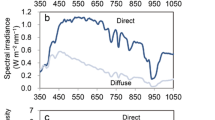Summary
Protonemata of Physcomitrium were grown in a sucrose-mineral nutrient, liquid medium. Even in this medium containing organic nutrient, the growth rate of lateral branch, chloronemal filaments showed a light dependence which was linear with log intensity. Intensities necessary to give a constant growth rate (45 μ/1.75 hrs.) were determined at selected wavelengths. The resulting action spectrum paralleled the in-vivo absorption spectrum of a single filament in the red region, showing a major peak at 680 nm. Growth rate and absorption approached zero in the far-red (730 nm). However, significant growth activity occurred at 365–400 nm where absorption was low, and negligible growth was found at 440–500 nm where absorption was high.
The action spectrum for the positive, directional photo-orientation of growth was determined by the null-point method in which the effectiveness of each selected wavelength was compared to a 665-nm standard in simultaneous, bilateral irradiation. In contrast to growth, the major peak of phototropic activity was found at 730 nm with significant activity extending to 800 nm. A minor peak was at 680 nm. There was some activity in near ultraviolet but not at longer blue wavelengths.
It is concluded that the blue-absorbing system responsible for phototropism in virtually all other groups of plants is inactive or absent in Physcomitrium. Instead growth and orientation seem to be dependent upon an interaction between the photosynthetic and phytochrome systems. Further, the data suggest that the physiological activity of phytochrome in photo-orientation of growth does not derive from a certain amount of Pfr or Pfr/Pr ratio but rather it derives from the simultaneous excitation and consequent cycling of Pr and Pfr.
Similar content being viewed by others
References
Arnon, D. I.: The chloroplast as a functional unit in photosynthesis. Handbuch der Pflanzenphysiologie (W. Ruhland, ed.), vol. V, p. 773–829. Berlin-Göttingen-Heidelberg: Springer 1960.
— H. Y. Tsujimoto, and B. D. McSwain: Ferredoxin and photosynthetic phosphorylation. Nature (Lond.) 214, 562–566 (1967).
Bopp, M.: Morphogenese der Laubmoose. Biol. Revs. 36, 237–280 (1961).
Briggs W. R. and D. C. Fork: Studies on phytochrome transformation in vitro. Carnegie Inst. Yearbook No. 64, p. 406–412 (1965).
Delbrück, M., and W. Shropshire: Action and transmission spectra of Phycomyces. Plant Physiol. 35, 194–204 (1960).
Etzold, H.: Der Polarotropismus und Phototropismus der Chloronemen von Dryopteris filix-mas (L.) Schott. Planta (Berl.) 64, 254–280 (1965).
Freeland, R. O.: Plastid pigments of gametophytes and sporophytes of Musci. Plant Physiol. 32, 64–66 (1957).
Hartmann, K. M.: A general hypothesis to interpret “high energy phenomena” of photomorphogenesis on the basis of phytochrome. Photochem. Photobiol. 5, 349–366 (1966).
Hartmann, K. M.: Photoreceptor problems in photomorphogenic responses under high-energy-conditions (UV-blue-far-red). In: Photochemistry and photobiology in plant physiology, Europ. Photobiol. Symp., Abstr. p. 29–32. Hvar, Yugoslavia (1967).
Hendricks, S. B., and H. A. Borthwick: Photocontrol of plant development by the simultaneous excitation of two interconvertible pigments. II. Theory and control of anthocyanin synthesis. Bot. Gaz. 120, 187–193 (1959).
Hillman, W. S.: The physiology of phytochrome. Ann. Rev. Plant Physiol. 18, 301–324 (1967).
Jaffe, L., and H. Etzold: Tropic responses of Funaria spores to red light. Biophys. J. 5, 715–742 (1965).
Jahn, H.: Die Wirkung von Blaulicht und Kinetin auf die Protonemaentwicklung und Knospenbildung von Funaria hygrometrica Sibth. Flora (Jena) 155, 10–29 (1964).
Kofler, L.: Contribution a l'étude biologique des mousses cultivées in vitro; Germination des spores, croissance et développement du protonéma chez Funaria hygrometrica. Rev. bryol. lichénol. 28, 1–202 (1959).
Lane, H. C., H. M. Cathey, and L. T. Evans: The dependence of flowering in several long-day plants on the spectral composition of light extending the photoperiod. Amer. J. Bot. 52, 1006–1014 (1965).
Linschitz, H., V. Kasche, W. Butler, and W. H. Siegelman: The kinetics of phytochrome conversion. J. Biol. Chem. 241, 3395–3403 (1966).
Miller, J. H., and P. M. Miller: Action spectra for light-induced elongation in fern protonemata. Physiol. Plantarum (Cph.) 20, 128–138 (1967).
Mitra, G. C., A. Allsopp, and P. F. Wareing: The effects of light of various qualities on the development of the protonema and bud formation in Pohlia nutans (Hedw.) Lindb. Phytomorphology 9, 47–55 (1959).
Mohr, H.: Die Abhängigkeit des Protonemawachstums und der Protonemapolarität bei Farnen von Licht. Planta (berl.) 47, 127–158 (1956).
Nebel, B. J., and A. W. Naylor: Initiation and development of shoot-buds from protonemata in the moss Physcomitrium turbinatum. Amer. J. Bot. 55, 33–37 (1968).
Page, R. M., and G. M. Curry: Studies on phototropism of young sporangiophores of Pilobolus kleinii. Photochem. Photobiol. 5, 31–40 (1966).
Pratt, L. H., and W. R. Briggs: Photochemical and nonphotochemical reactions of phytochrome in vivo. Plant Physiol. 41, 467–474 (1966).
Pringsheim, E., u. O. Pringsheim: Physiologische Studien an Moosen. III. Die Züchtung von Laubmoosprotonemen im Dunkeln. Jb. wiss. Bot. 82, 311–332 (1935).
Shropshire, W.: The lens effect and phototropism of Phycomyces. J. Gen. Physiol. 45, 949–958 (1962).
Siegelman, H. W., and W. L. Butler: Properties of phytochrome. Ann. Rev. Plant Physiol. 16, 383–392 (1965).
Taylor, A. O., and B. A. Bonner: Isolation of phytochrome from the alga Mesotaenium and liverwort Sphaerocarpus. Plant Physiol. 42, 762–766 (1967).
Valanne, N.: The germination phases of moss spores and their control by light. Ann. Bot. Fenn. 3, 1–60 (1966).
Withbow, R. B., W. H. Klein, and V. Elstad: Action spectra of photomorphogenic induction and its photoinactivation. Plant Physiol. 32, 453–462 (1957).
—, and A. P. Withrow: Generation, control and measurement of visible and near visible radiation. Radiation biology, vol. III (A. Hollaender, ed.), p. 125–258. New York: McGraw-Hill 1956.
Author information
Authors and Affiliations
Additional information
Published with the approval of the Secretary of the Smithsonian Institution.
This work was carried out under partial support by the U.S. Atomic Energy Commission under Contract AT(30-1)2373.
Rights and permissions
About this article
Cite this article
Nebel, B.J. Action spectra for photogrowth and phototropism in protonemata of the moss Physcomitrium turbinatum . Planta 81, 287–302 (1968). https://doi.org/10.1007/BF00391164
Received:
Issue Date:
DOI: https://doi.org/10.1007/BF00391164




